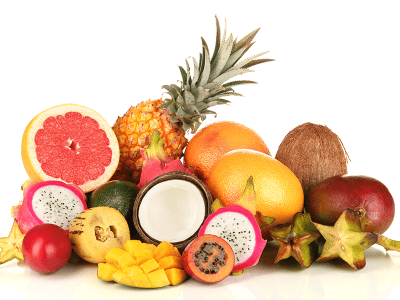
The idea was popularized by physician Dr Peter D’Adamo in 1996.
According to D’Adamo this is how people of various blood groups should eat:
- A: People with blood group A are to eat a diet rich in plants, and completely free of “toxic” red meat. This closely resembles a vegetarian diet.
- B: These people can eat plants and most meats (except chicken and pork), and can also eat some dairy. However, they should avoid wheat, corn, lentils, tomatoes and a few other foods.
- AB: Described as a mix between types A and B. Foods to eat include seafood, tofu, dairy, beans and grains. They should avoid kidney beans, corn, beef and chicken.
- O: This is a high-protein diet based largely on meat, fish, poultry, certain fruits and vegetables, but limited in grains, legumes and dairy. It closely resembles the paleo diet.

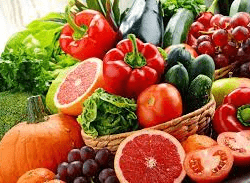

FOOD LIST FOR A
❏ Soy milk ❏ Eggs ❏ Ghee ❏ Mozzarella cheese ❏ Feta cheese ❏ Ricotta ❏ Goat cheese
❏ Tofu ❏ Tempeh ❏ Chicken ❏ Turkey ❏ Cod ❏ Salmon ❏ Red snapper ❏ Trout
❏ Artichokes ❏ Broccoli ❏ Carrots ❏ Celery ❏ Fennel ❏ Kale ❏ Lettuce ❏ Onions ❏ Pumpkin (when in season) ❏ Spinach ❏ Apricots ❏ Blueberries ❏ Cherries ❏ Figs ❏ Pineapple ❏ Grapefruit
❏ Olive oil ❏ Walnut oil ❏ Flaxseeds ❏ Walnuts ❏ Peanuts ❏ Peanut butter ❏ Pumpkin seeds ❏ Adzuki beans ❏ Soy beans ❏ Lentil beans ❏ Black-eyed peas ❏ Brown rice bread ❏ Soy sauce ❏ Garlic ❏ Ginger ❏ Ginger tea ❏ Chamomile tea ❏ Green tea ❏ Coffee ❏ Red wine
❏ Brown rice flour ❏ Buckwheat flour ❏ Oat flour ❏ Spelt flour ❏ Brown rice flour ❏ Baking powder ❏ Sea salt ❏ Agave ❏ Blackstrap molasses
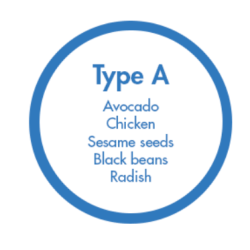
Eat more of
Salmon
Fig
Soy Milk
Beet
Portobello Mushroom
Grapefruit
Turnip/Parsnip
Lentils
Kale
Cod
Spelt Noodles
Coffee
Eat less of
Beef
Banana
Cow’s Milk
Tomatoes
Eggplant
Orange
Potatoes
Garbanzo Beans
Cabbage
Pork
Wheat Pasta
Tea (Black)
- Diet Profile
Largely vegetarian: vegetables, tofu, seafood, grains, legumes, fruit, turkey - Quick Food Reference
Avoid: meat, dairy, kidney beans, lima beans
Beneficial: olive oil, seafood, vegetables, pineapple - Strengths
Ability to adapt well to dietary and environmental variety
System synchronized to preserve and metabolize nutrients efficiently - Weaknesses
Difficulty digesting and metabolizing meat protein
Vulnerable immune system, open to microbial invasion - Medical Risks
Heart disease, type I and type II diabetes, cancer
Liver and gallbladder disorders
FOOD LIST FOR B
❏ Eggs ❏ Butter ❏ Mozzarella cheese ❏ Feta cheese ❏ Cottage cheese ❏ Goat cheese ❏ Ricotta ❏ Cow milk ❏ Yogurt
❏ Lamb ❏ Venison ❏ Turkey ❏ Cod ❏ Flounder ❏ Salmon ❏ Mahi Mahi ❏ Halibut
❏ Beets ❏ Broccoli ❏ Cabbage ❏ Carrots ❏ Eggplant ❏ Ginger ❏ Kale ❏ Peppers ❏ Sweet potatoes ❏ Bananas ❏ Cranberries ❏ Grapes ❏ Pineapple ❏ Watermelon
❏ Spelt flour ❏ Brown rice flour ❏ Oat flour ❏ Millet flour ❏ Baking powder ❏ Sea salt ❏ Blackstrap molasses ❏ Agave
❏ Olive oil ❏ Walnuts ❏ Almonds ❏ Almond butter ❏ Kidney beans ❏ Navy beans ❏ Spelt bread ❏ Oat bread ❏ Parsley ❏ Pepper, cayenne ❏ Ginger tea ❏ Peppermint tea ❏ Green tea
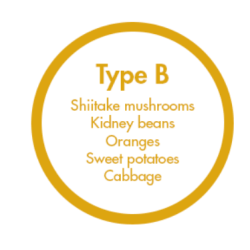
Eat more of
Lamb
Broccoli
Oat Bread
Kidney Beans
Almonds
Peppers
Rice Cakes / Bran
Olive Oil
Mozzarella Cheese
Cod
Banana
Green Tea
Eat less of
Chicken
Corn
Wheat Bread
Lentils
Peanuts
Tomatoes
Couscous
Canola Oil
American Cheese
Crab
Coconut
Coffee
- Diet Profile
Balanced omnivore: meat, dairy, grains, fruits, vegetables, fish, seafood, select beans, legumes - Quick Food Reference
Avoid: chicken, corn, lentils, peanuts, sesame seeds, wheat
Beneficial: greens, eggs, venison, liver, licorice tea
- Strengths
Strong immune system, easily adapts to dietary and environmental changes
Balanced nervous system - Weaknesses
Tendency toward autoimmune disease and rare, slow-growing viruses - Medical Risks
Type I diabetes, chronic fatigue, Lou Gehrig’s disease (ALS), multiple sclerosis, autoimmune diseases such as lupus
FOOD LIST FOR AB
❏ Eggs ❏ Ghee ❏ Mozzarella cheese ❏ Feta cheese ❏ Cottage cheese ❏ Goat cheese ❏ Ricotta ❏ Goat milk ❏ Yogurt
❏ Lamb ❏ Turkey ❏ Cod ❏ Salmon ❏ Mahi Mahi ❏ Tuna ❏ Red Snapper
❏ Beets ❏ Broccoli ❏ Cauliflower ❏ Eggplant ❏ Kale ❏ Garlic ❏ Parsnip ❏ Sweet potatoes ❏ Figs ❏ Grapes ❏ Grapefruit ❏ Pineapple ❏ Watermelon
❏ Olive oil ❏ Walnuts ❏ Peanuts ❏ Almonds ❏ Peanut butter ❏ Lentils ❏ Navy beans ❏ Soy beans ❏ Tempeh ❏ Tofu ❏ Spelt bread ❏ Oat bread ❏ Sprouted wheat ❏ Parsley ❏ Curry ❏ Ginger tea ❏ Chamomile tea ❏ Green tea ❏ Red wine
❏ Spelt flour ❏ Brown rice flour ❏ Oat flour ❏ Soy flour ❏ Baking powder ❏ Sea salt ❏ Blackstrap molasses ❏ Agave
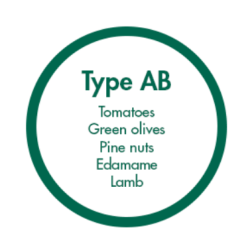
Eat more of
Turkey
Pinto Beans
Kale
Sweet Potato
Spelt
Cod
Kefir
Oatmeal
Mozzarella Cheese
Eggplant
Parsnips
Pineapple
Eat less of
Red Meat
Kidney Beans
Corn
White Potatoes
Buckwheat
Sea Bass
Ice Cream
Corn Flakes
American Cheese
Peppers
Lima Beans
Mango
- Diet Profile
Mixed diet: lamb, fish, dairy, tofu, beans, legumes, grains, vegetables, fruit - Quick Food Reference
Avoid: chicken, corn, kidney beans, buckwheat
Beneficial: tofu, seafood, greens, kelp
- Strengths
Versatile system designed for modern conditions
Highly tolerant immune system - Weaknesses
Sensitive digestive tract, open to microbial invasion - Medical Risks
Heart disease, cancer
FOOD LIST FOR O
❏ Eggs ❏ Butter ❏ Mozzarella cheese ❏ Feta cheese
❏ Beef ❏ Lamb ❏ Turkey ❏ Cod ❏ Red snapper ❏ Halibut
❏ Artichokes ❏ Broccoli ❏ Kale ❏ Lettuce ❏ Onion ❏ Sweet potatoes ❏ Spinach ❏ Bananas ❏ Blueberries ❏ Cherries ❏ Figs ❏ Mangos ❏ Watermelon
❏ Olive oil ❏ Flaxseeds ❏ Walnuts ❏ Almonds ❏ Almond butter ❏ Adzuki beans ❏ Black-eyed peas ❏ Brown rice bread ❏ Curry powder ❏ Carob ❏ Parsley ❏ Pepper, cayenne ❏ Ginger tea ❏ Green tea ❏ Seltzer
❏ Brown rice flour ❏ Millet flour ❏ Arrowroot starch ❏ Baking powder ❏ Sea salt ❏ Agave
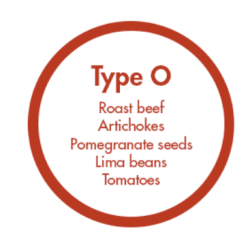
Eat more of
Spelt/Brown Rice Bread
Almond Milk
Lean Grass Fed Beef
Kale
Cod
Broccoli
Turnip/Parsnip
Azuki Beans
Walnuts
Olive Oil
Artichokes
Pineapple Juice
Eat less of
Wheat & Gluten
Cow’s Milk & Dairy
Pork
Corn
Catfish
Cabbage
Potatoes
Navy Beans
Peanuts
Canola Oil
Olives
Orange Juice
- Diet Profile
High protein: meat, fish, vegetables, fruit, limited grains, beans, legumes - Quick Food Reference
Avoid: wheat, corn, navy beans, lentils, kidney beans, dairy
Beneficial: kelp, seafood, red meat, kale, spinach, broccoli, olive oil
- Strengths
Hardy digestive tract, strong immune system, natural defenses against infections
System synchronized to preserve and metabolize nutrients efficiently - Weaknesses
Difficulty adjusting to new dietary and environmental conditions
Tendency toward an overactive immune system - Medical Risks
Blood-clotting disorders, low thyroid production, ulcers, allergies, inflammatory diseases such as arthritis
Blood group diet criticisms
In his book, Eat Right 4 Your Type, naturopathic physician Dr Peter D’Adamo claims that the optimal diet for any one individual depends on the person’s blood type.①
The book was incredibly successful. It was a New York Times bestseller, sold millions of copies.
However, the diet D’Adamo proposes for different blood types is in several cases suitable for all.
Also, discouraging people of certain blood groups some foods can be counter productive for their health and making people to consume too much of a certain line of foods may sometimes cause health issues.

Thoughts
The blood group diet theory lacks sufficient scientific evidence. The list of foods on it is OK but not restricted to blood group.
Any of these dietary patterns would be an improvement for most people, no matter what their blood type is.
So, even if you go on one of these diets and your health improves, it doesn’t necessarily mean that it had anything to do with your blood type.
All 4 diets (or “ways of eating”) are mostly based on real, healthy foods, and a huge step up from the standard Western diet of processed junk food.
If you got great results on the blood type diet, then perhaps you simply found a diet that happens to be appropriate for your metabolism. It may not have had anything to do with your blood type.
Also, this diet removes the majority of unhealthy processed foods from people’s diets.
Perhaps that is the single biggest reason that it works, without any regard to the different blood types.
Risks of following a blood type diet
Despite the lack of scientific evidence of the blood type diet, it remains a topic of discussion in the diet culture.
The four diets in the blood type diet emphasize eating healthy whole foods and exercising, which can be beneficial to your health. But the diet could still be risky.
For example, the O blood type diet emphasizes a high intake of animal proteins, which may lead to other health problems.③
Your blood type alone doesn’t determine your overall health, and you may put yourself at risk by engaging in the blood type diet without taking other foods that might be of help to your body.
References
① https://dadamo.com
② https://www.4yourtype.com
③ https://www.healthline.com/health/O-positive-blood-type-diet#risks














